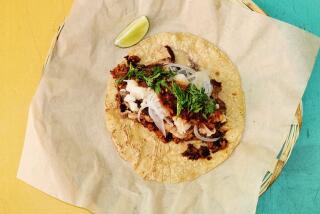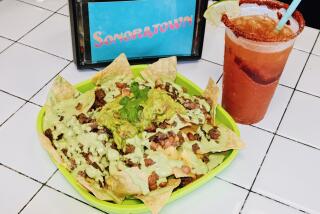Scientists Quest for the Tortilla of the Future
- Share via
“Makes you wonder how they did it in the old days,” joshed an old boy with a Texas accent. We were looking at a wall full of charts and diagrams from studies titled “Effects of Hot-Press Dwell Time and Pressure on Wheat Flour Tortilla Properties” and the like.
May 21 was the opening day of a tortilla industry conference at the Industry Hills Sheraton Resort and Convention Center in the City of Industry, which would wind up two days later with discussions of “Encapsulation Technology” and “Water-Soluble Gums (Hydrocolloids) in Tortillas.” The members of the sponsoring organization, the 11-year-old Tortilla Industry Assn., are serious about tortillas.
We drifted into the hall. The first speaker was Ralph Waniska, who actually co-wrote the study on hot-press dwell time. His subject was “How to Increase Diameter and Opacity of Wheat Flour Tortillas.” Hot pressing (how hot, how much pressure and, of course, how much dwell time) was one factor, but to get a nice big, opaque tortilla, it turned out, you need the right wheat too. The problem is, most wheat is raised for bread, so it has strong gluten to hold together as it rises and bakes; tortillas need extensible gluten for the old hot press.
This much is obvious, but it turns out there’s also a world of technicalities involved in producing the tiny bubbles that make tortilla dough opaque, rather than translucent. You wouldn’t believe how many kinds of baking soda there are. And for maximum opacity, never ask a slow-acting soda and a slow-acting acid to react with each other--one should always be slow and the other fast.
“I’m on the record--we don’t use enough emulsifiers,” added Waniska. “Emulsifiers do good things for proteins, starch and air bubbles.”
Now, with corn tortillas, as against flour tortillas, that’s not an issue, because the alkalinity of the limed corn reacts with the fat in the masa and creates its own emulsifiers. But that doesn’t mean the traditional corn tortilla is a perfect product. In his seminar “Tortilla Technology--Past, Present and Future,” Juan de Dios Figueroa Cardenas dwelt on its flaws, among them polluting wastes and the loss of 5% to 15% of the nutritional content of the corn. In addition to advocating new tortilla-making techniques, he strongly favored enriching tortillas with soy flour, a new version of the well-known nutritional synergy of corn and beans.
One of those academic studies displayed outside the seminar hall had also pointed out that adding 5% soy flour makes for a more flexible corn tortilla that doesn’t stale as fast. Another paper found that adding 10% barley to a flour tortilla made for a more nutritious, better-textured tortilla, and there was even a study of stylish brown and black tortillas made from sorghum grain. The tortilla industry, which today boasts sales that exceed all other ethnic and specialty breads, including pita and bagels, may end up being a multi-grain flatbread industry, not limited to wheat and corn.
But what’s all this stuff about opacity? “Why is opacity so important?” I asked Waniska.
“People expect it,” he said. “It makes the tortilla look done, like blisters and brown spots.”
Aha. This explains why the soy study had carefully pointed out that soy makes for more brown spots. OK, between a tortilla enriched with soy, barley or sorghum, which would he rather eat?
“Barley,” Waniska said eagerly. “In fact, a 100% barley tortilla is better than a 100% corn tortilla. It’s a wonderful product. The only problem is that so many people expect a corn flavor.”
More to Read
Eat your way across L.A.
Get our weekly Tasting Notes newsletter for reviews, news and more.
You may occasionally receive promotional content from the Los Angeles Times.









